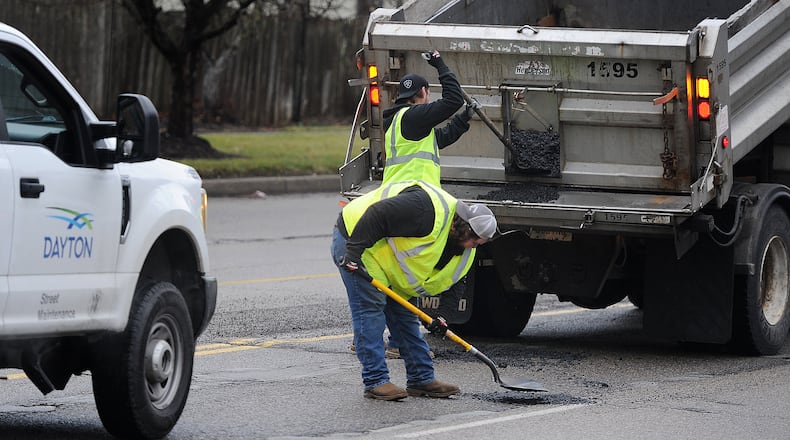That fluctuation, accompanied by multiple days of precipitation, created ideal conditions for potholes to form, transportation officials said.
“The base reason for a pothole to form is when water gets down under the surface of the roadway, it freezes and expands, then it thaws and contracts, and when you get traffic driving over that, it creates a void on the roadway,” said Ohio Department of Transportation spokesman Matt Bruning. “Over time, traffic is running over that asphalt with a void underneath, and eventually the pavement will give way.”
While Ohio drivers are used to late-winter and early-spring potholes, problems for drivers started in January this year. On Jan. 26, I-75 southbound was completely closed for a few hours near Stanley Avenue, so crews could repair large potholes capable of damaging cars.
Common issues caused by striking a pothole can include flat tires, dented rims, damaged wheels, dislodged wheel weights, displaced struts, dislocated shock absorbers, damaged exhaust systems, misaligned steering systems, and ruptured ball joints, AAA officials said.
A recent survey by the agency found that one in 10 drivers who hit a pothole sustained vehicle damage significant enough to warrant a repair, which can cost up to $600 on average.
Along with the financial burden, hitting a pothole can in itself be dangerous, especially on busy roadways.
“It you’re on a major roadway and you hit a pothole and find your vehicle disabled in some way, try to get as far off the road as you can, stay in your car, and keep your seatbelt on, and then call for help, whether that’s from a tow truck or law enforcement,” Bruning advised. “Over the years, we’ve seen too many crashes occurring when someone gets out of their car to look at the damage and get hit while doing so.”
Within city limits, local governments are in charge of maintaining most non-interstate roadways, and their crews are already busy too. Most cities are made aware of roadway issues, including potholes, via observation by their own road maintenance crews, as well as alerts from drivers.
In Trotwood, residents can call the city offices to report concerns, as well as through the city’s website and GovPilot app.
“Some of our public works staff will notice potholes when performing other duties, (or) other employees will contact public works when they notice concerns,” said Deputy City Manager Stephanie Kellum. “Bus drivers from the schools will also notify us of concerns they see.”
Vandalia offers residents its MyVandalia app, which allows users to notify the city of hazardous road conditions by submitting a photo of the pothole. The app then pinpoints the location of the pothole so crews know exactly where to respond.
“When we learn of a pothole, we try to get it filled the same day,” said Vandalia spokesman Rich Hopkins.
Whether statewide or locally, the process of fixing a pothole is the same. The degree to which a pothole is alleviated depends on the time of year it’s being addressed and the type of repair material used, officials said.
“In the winter season, we use a material called Cold Patch (asphalt), which is a Band-Aid,” Bruning said. “In the summer, we’re using a hot asphalt mix, which is made at an asphalt plant.”
Asphalt plants, which need temperatures consistently above 50 degrees in order to operate, close during the winter months.
Road crews can temporarily fix a pothole with a cold patch and return later with the more durable hot asphalt solution.
“Once asphalt plants open, if the hole is in need of a more permanent fix, we will square open the hole and put asphalt in and vibrate or roll the material,” said Clayton Public Service Director Randy Sanders.
Huber Heights Public Works Manager Michael Gray said the repairs his crews implement depend on a number of variables, including the season, area road conditions, and road usage.
“Typically, this time of year, reported potholes are checked daily for concerns of safety or damage to a vehicle,” Gray said. “They are then addressed with any required available method. Some of these repairs may be classified as permanent, temporarily permanent, or scheduled for future total replacement or repair.”
According to Bruning, a cold patch can potentially last years on roads that see less daily traffic.
“But on a roadway like I-75, it could last a week or two, or it could last a month. It just depends on the location and conditions,” he said. “If the freeze-thaw cycle happens again, or if it rains really heavily and there’s a lot of moisture on the roadway, it’s going to reduce the structure of that cold patch.”
Drivers who sustain vehicle damage on ODOT-controlled roadways (interstates and the parts of state/U.S. routes outside of municipalities) can seek reimbursement for repairs by filing a claim with the Ohio Court of Claims. Information on how to do so is available at www.transportation.ohio.gov/damagereport.
A non-refundable filing fee of $25 does apply, according to the Ohio Court of Claims website.
The court will take into consideration a number of factors, Bruning said, including whether or not the pothole had been reported to ODOT, by any party, prior to a driver sustaining damage, and whether the agency had adequate time to fix the issue prior to the incident reported in the claim.
Potholes and other road hazards can be reported to ODOT at www.transportation.ohio.gov/damagereport. For more urgent reports, call the Ohio State Highway Patrol at #677.
About the Author


